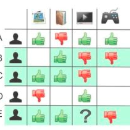The performance of a Collaborative Filtering (CF) method is based on the properties of a User-Item Rating Matrix (URM). And the properties or Rating Data Characteristics (RDC) of a URM are constantly changing. Recent studies significantly explained the variation in the performances of CF methods resulted due to the change in URM using six or more RDC. Here, we found that the significant proportion of variation in the performances of different CF techniques can be accounted to two RDC only. The two RDC are the number of ratings per user or Information per User (IpU) and the number of ratings per item or Information per Item (IpI). And the performances of CF algorithms are quadratic to IpU (or IpI) for a square URM. The findings of this study are based on seven well-established CF methods and three popular public recommender datasets: 1M MovieLens, 25M MovieLens, and Yahoo! Music Rating datasets
翻译:Collaborative Filtering(CF)方法的性能基于用户-项目评分矩阵(URM)的特性。评分数据特征(RDC)不断变化,这会显著地解释了CF方法的不同性能变化。最近的研究发现,使用六个或更多RDC可以显着地解释CF方法性能的变化。在这项研究中,我们发现不同CF技术的性能变化中有重要的比例可以用两个RDC解释。这两个RDC是每个用户的评分数量或每个用户的信息(IpU)以及每个项目的评分数量或每个项目的信息(IpI)。对于一个平方矩阵URM,CF算法的表现是IpU(或IpI)的二次方。本研究的结果基于七种经过良好验证的CF方法和三个流行的公共推荐数据集:1M MovieLens,25M MovieLens和Yahoo! 音乐评分数据集。




